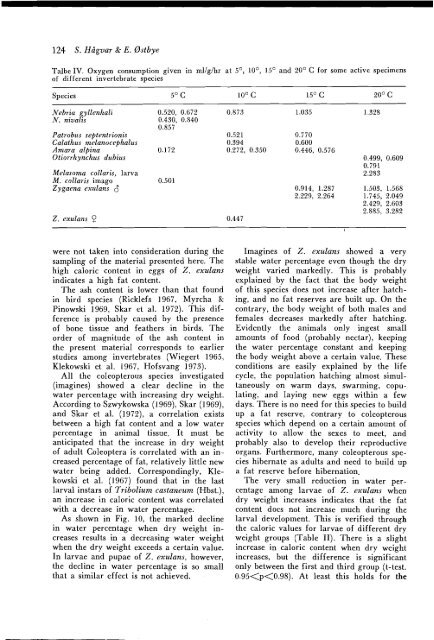Full-text - Norsk entomologisk forening
Full-text - Norsk entomologisk forening
Full-text - Norsk entomologisk forening
Create successful ePaper yourself
Turn your PDF publications into a flip-book with our unique Google optimized e-Paper software.
Talbe IV. Oxygen consumption given in mligihr at 5O, lo0, 15' and 20' C for some active specimens<br />
of different invertebrate species<br />
Species 5" C lo0 C 15' C 20° C<br />
Nebria gyllenhali<br />
N. niualis<br />
Patrobus septentrionis<br />
Calathus melanocephalus<br />
Anzara alpina<br />
Otiorrhynchus dubius<br />
Melasoma collaris, larva<br />
M. collaris imago<br />
Zygaena exulans $<br />
Z. exulans 9<br />
were not taken into consideration during the<br />
sampling of the material presented here. The<br />
high caloric content in eggs of 2. exulans<br />
indicates a high fat content.<br />
The ash content is lower than that found<br />
in bird species (Ricklefs 1967, Myrcha &<br />
Pinowski 1969, Skar et al. 1972). This difference<br />
is probably caused by the presence<br />
of bone tissue and feathers in birds. The<br />
order of magnitude of the ash content in<br />
the present material corresponds to earlier<br />
studies among invertebrates (Wiegert 1965,<br />
Klekowski et al. 1967, Hofsvana 1973).<br />
u<br />
Al1 the coleopterous species investigated<br />
(imagines) showed a clear decline in the<br />
\ u ,<br />
water percentage with increasing dry weight.<br />
According to Szwykowska (1969), Skar (1969),<br />
and Skar et al. (1972), a correlation exists<br />
between a hiah fat content and a low water<br />
u<br />
percentage in animal tissue. It must be<br />
anticipated that the increase in dry weight<br />
of adult Coleoptera is correlated with an increased<br />
percentage of fat, relatively little new<br />
water being added. Correspondingly, Klekowski<br />
et al. (1967) found that in the last<br />
larva1 instars of 'Tribolium castaneum (Hbst.),<br />
an increase in caloric content was correlated<br />
with a decrease in water percentage.<br />
As shown in Fig. 10, the marked decline<br />
in water percentage when dry weight increases<br />
results in a decre'asing water weight<br />
when the dry weight exceeds a certain value.<br />
In larvae and pupae of 2. exulans, however,<br />
the decline in water percentage is so small<br />
that a similar effect is not achieved.<br />
Imagines of 2. exulans showed a very<br />
stable water percentage even though the dry<br />
weight varied markedly. This is probably<br />
explained by the fact that the body weight<br />
of this species does not increase after hatching,<br />
and no fat reserves are built up. On the<br />
contrary, the body weight of both males and<br />
females decreases markedly after hatching.<br />
Evidently the animals only ingest small<br />
amounts of food (probably nectar), keeping<br />
the water percentage constant and keeping<br />
the body weight above a certain value. These<br />
conditions are easily explained by the life<br />
cycle, the population hatching almost simultaneously<br />
on warm days, swarming, copulating,<br />
and laying new eggs within a few<br />
days. There is no need for this species to build<br />
up a fat reserve, contrary to coleopterous<br />
species which depend on a certain amount of<br />
activity to allow the sexes to meet, and<br />
probably also to develop their reproductive<br />
organs. Furthermore, many coleopterous species<br />
hibernate as adults and need to build up<br />
a fat reserve before hibernation.<br />
The very small reduction in water percentage<br />
among larvae of 2. exulans when<br />
dry weight increases indicates that the fat<br />
content does not increase much during the<br />
larva1 development. This is verified through<br />
the caloric values for larvae of different dry<br />
weight groups (Table TI). There is a slight<br />
increase in caloric content when dry weight<br />
increases, but the difference is significant<br />
only between the first and third group (t-test.<br />
0.95

















